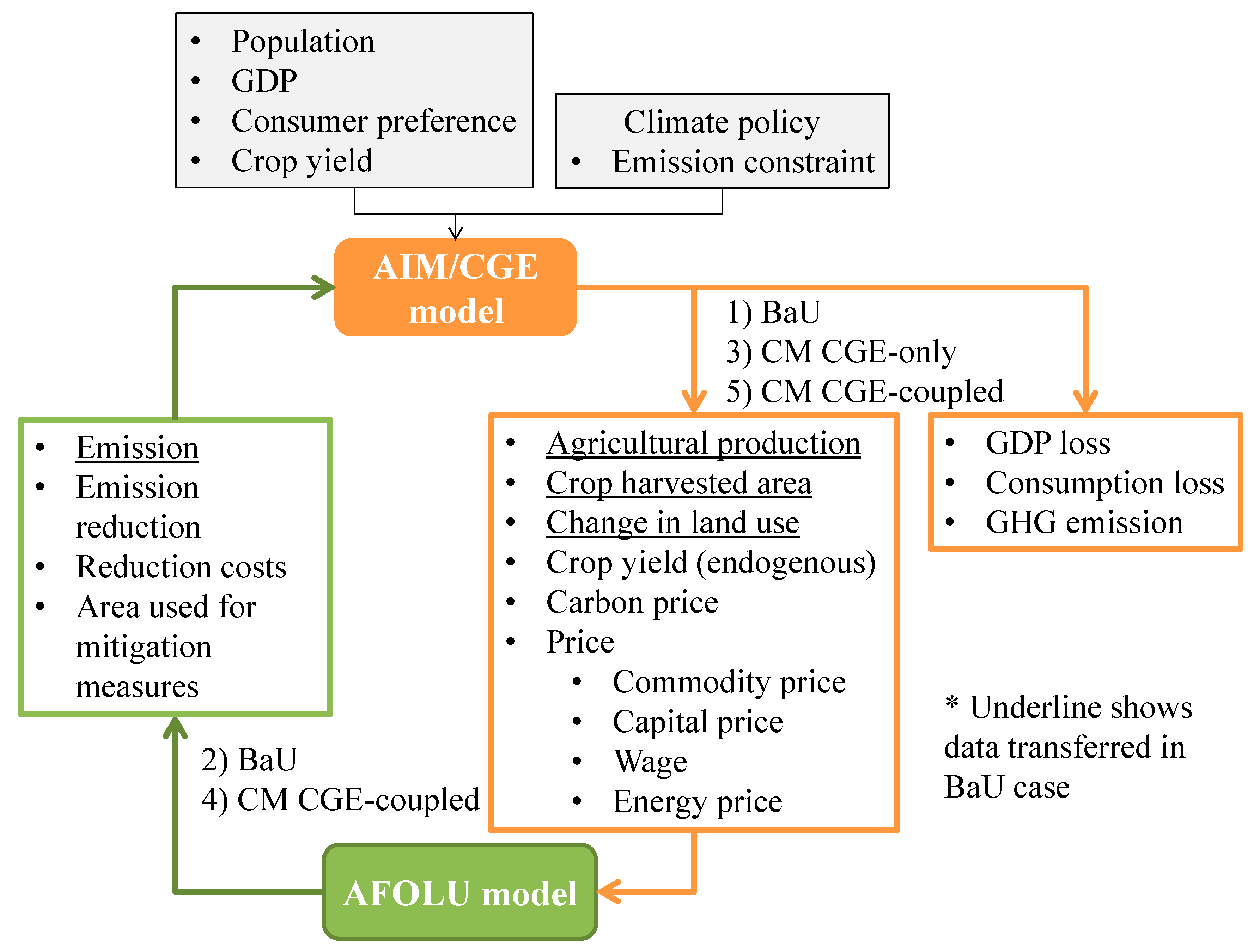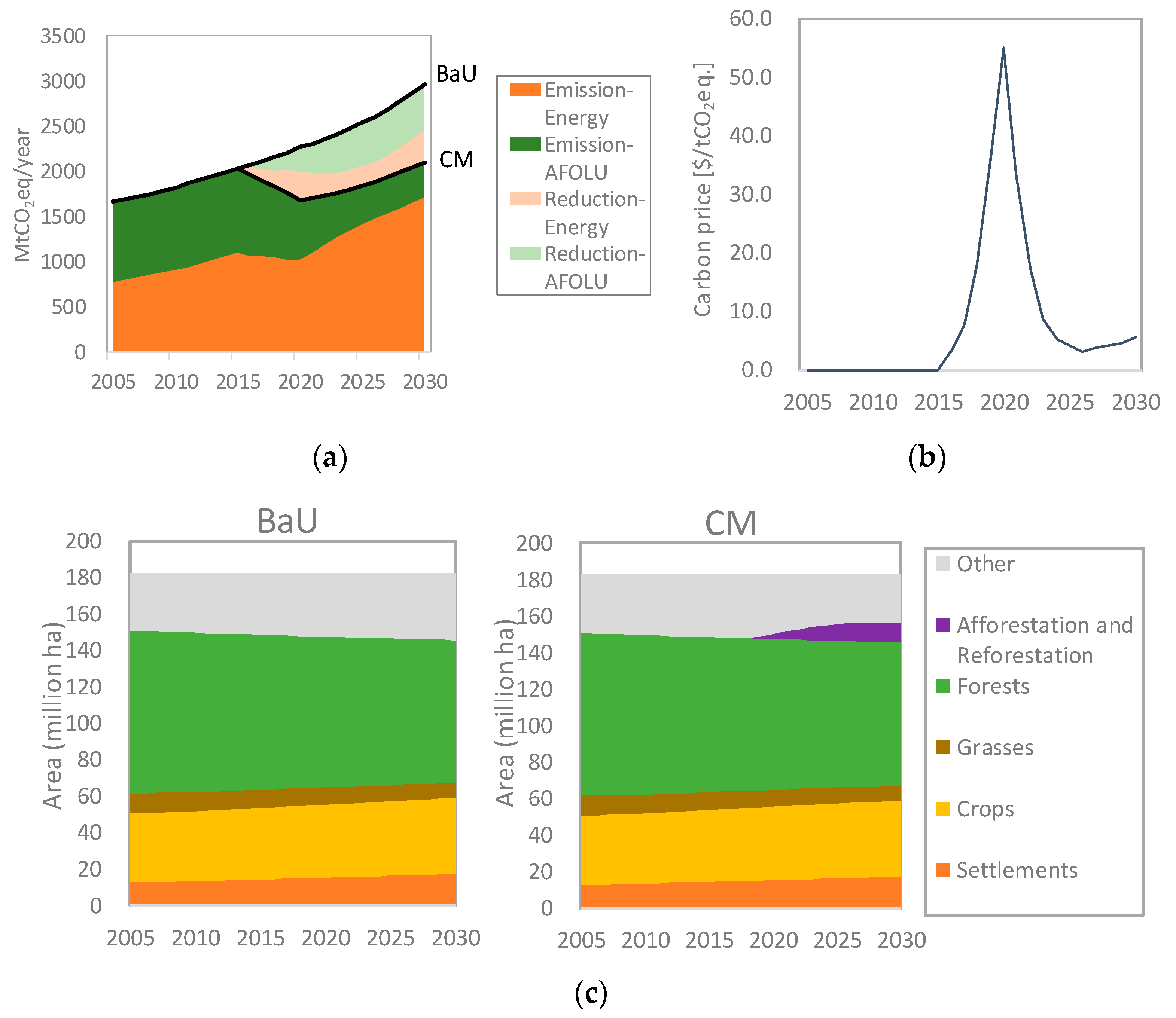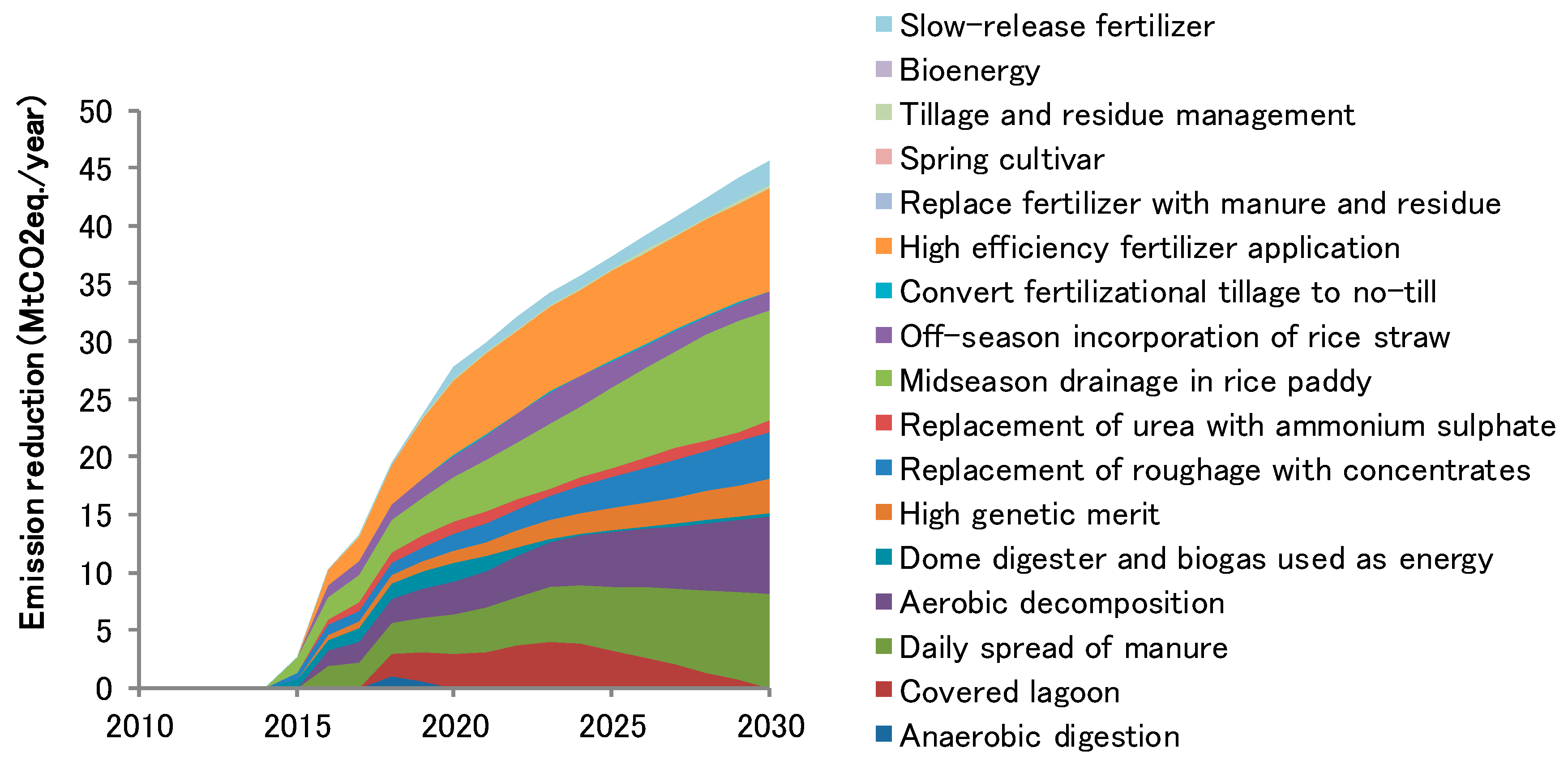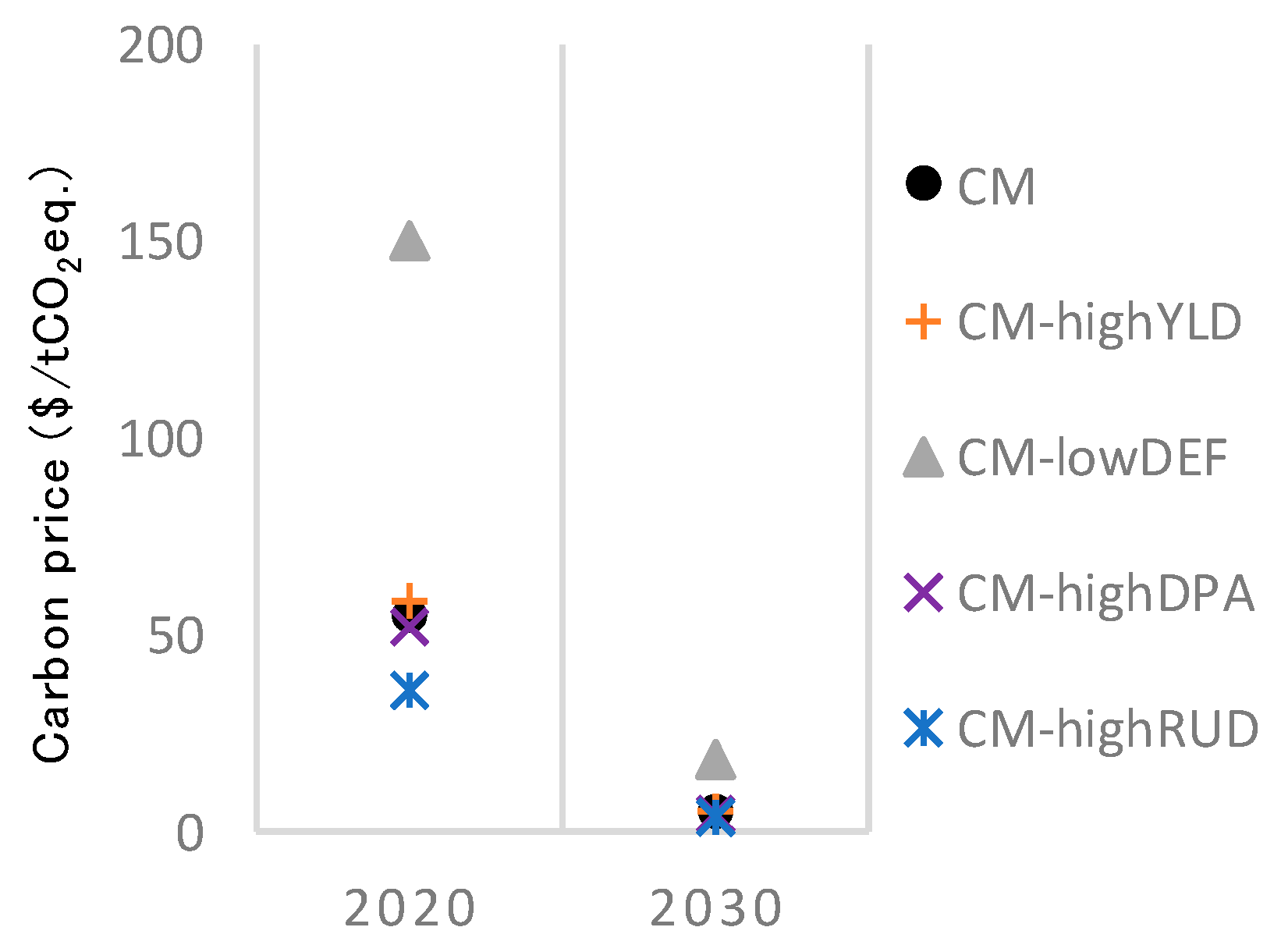Land-Based Mitigation Strategies under the Mid-Term Carbon Reduction Targets in Indonesia
Abstract
:1. Introduction
2. Methodology
2.1. Model Framework
2.2. Scenario Matrix Design
2.3. Data
3. Results
3.1. Overview of Future Trends
3.2. Carbon Emission Reduction: Key Land-Based Options
3.3. Sensitivity Analysis
4. Discussion
4.1. Key Findings and Policy Implications
4.2. Limitations and Future Work
- Spatial distribution of land-use in the country was not taken into account. Gridded agro-ecological information could help clarify the spatial distribution of suitable areas for implementing mitigation measures and provide more useful information in future analyses;
- The cost for reducing unplanned deforestation is difficult to define since reducing deforestation can be realized through many activities, including implementing forest monitoring, empowering communities surrounding threatened forests (e.g., providing alternative livelihood communities, improving crop productivity, changing from shifting cultivation into permanent agriculture), institutional development and empowering forest management groups;
- Ecosystem services maintained by reducing deforestation were not considered in the study. Therefore, our consumption loss might be a pessimistic estimate. Integrating this into the models as a monetary value could provide a new perspective to land-based mitigation measures.
Acknowledgments
Author Contributions
Conflicts of Interest
Appendix A
| Commodities | Yield of Annual Crops (t/ha) | |||
|---|---|---|---|---|
| 2030 | ||||
| 2010 | BaU | CM | CM-highYLD | |
| Rice paddy | 5.0 | 5.9 | 6.0 | 6.3 |
| Other cereals (mainly Maize) | 4.4 | 4.7 | 5.2 | 5.6 |
| Vegetables | 9.0 | 9.5 | 10.0 | 0.4 |
| Oil Crops | 5.3 | 7.0 | 7.0 | 7.0 |
| Other Crops | 0.9 | 1.1 | 1.1 | 1.1 |
| Cassava | 20.2 | 23.1 | 24.6 | 27.2 |
| Sugar crops (mainly sugar cane) | 47.9 | 56.5 | 61.0 | 65.3 |
| Fruits and Nuts | 10.7 | 11.3 | 11.8 | 12.3 |
| Industrial crop | 0.9 | 1.0 | 1.1 | 1.1 |
| Palm oil (FFB) | 16.1 | 22.7 | 23.4 | 24.1 |
| 2010 | BaU | CM | CM-lowDEF | |
| Deforestation Rate (000 ha/year) | 500 | 352 | 175 | |
| Power Source | BaU | CM | ||
|---|---|---|---|---|
| 2020 | 2030 | 2020 | 2030 | |
| Coal | 65.9% | 69.8% | 65.9% | 68.6% |
| Oil | 1.6% | 0.4% | 1.6% | 1.4% |
| Gas | 24.9% | 26.1% | 23.8% | 20.2% |
| Geothermal | 2.6% | 1.3% | 3.4% | 5.0% |
| Hydropower | 4.9% | 2.4% | 5.2% | 4.8% |
References
- Intended Nationally Determined Contributions (INDC) Republic of Indonesia. Available online: http://www4.unfccc.int/Submissions/INDC/Submission%20Pages/submissions.aspx (accessed on 10 July 2016).
- Boer, R. Economic Assessment of Mitigation Options for Enhancing and Maintaining Carbon Sink Capacity in Indonesia. Mitig. Adapt. Strategies Glob. Chang. 2001, 6, 257–290. [Google Scholar] [CrossRef]
- Sathaye, J.A.; Makundi, W.R.; Andrasko, K.; Boer, R.; Ravindranath, N.H.; Sudha, P.; Zuomin, S. Carbon mitigation potential and costs of forestry options in Brazil, China, India, Indonesia, Mexico, the Philippines and Tanzania. Mitig. Adapt. Strategies Glob. Chang. 2001, 6, 185–211. [Google Scholar] [CrossRef]
- Boer, R.; Wasrin, U.R.; Dasanto, B.D.; Makundi, W.; Hero, J.; Ridwan, M.; Masripatin, N. Assessment of carbon leakage in multiple carbon-sink projects: A case study in Jambi Province, Indonesia. Mitig. Adapt. Strategies Glob. Chang. 2007, 12, 1169–1188. [Google Scholar] [CrossRef]
- DNPI (Dewan Nasional Perubahan Iklim). Indonesia’s Greenhouse Gas Abatement Cost Curve. Available online: http://www.mmechanisms.org/document/country/IDN/Indonesia_ghg_cost_curve_english.pdf (accessed on 4 Octorber 2011).
- Page, S.E.; Siegert, F.; Rieley, J.O.; Boehm, H.-D.V.; Jaya, A.; Limin, S. The amount of carbon released from peat and forest fires in Indonesia during 1997. Nature 2002, 420, 61–65. [Google Scholar] [CrossRef] [PubMed]
- Van Der Werf, G.R.; Dempewolf, J.; Trigg, S.N.; Randersn, J.T.; Kasibhatla, P.S.; Giglio, L.; DeFries, R.S. Climate regulation of fire emissions and deforestation in equatorial Asia. In Proceedings of the National Academy of Sciences; Field, C.B., Ed.; Carnegie Institution of Washington: Stanford, CA, USA, 2008; Volume 105, pp. 20350–20355. [Google Scholar]
- Murdiyarso, D.; Hergoualc’h, K.; Verchot, L.V. Opportunities for reducing greenhouse gas emissions in tropical peatlands. In Proceedings of the National Academy of Sciences; DeFries, R.S., Ed.; Columbia University: New York, NY, USA, 2010; Volume 107, pp. 19655–19660. [Google Scholar]
- Hooijer, A.; Page, S.; Canadell, J.G.; Silvius, M.; Kwadijk, J.; Wösten, H.; Jauhiainen, J. Current and future CO2 emissions from drained peatlands in Southeast Asia. Biogeosciences 2010, 7, 1505–1514. [Google Scholar] [CrossRef]
- Miettinen, J.; Hooijer, A.; Shi, C.; Tollenaar, D.; Vernimmen, R.; Liew, S.C.; Page, S.E. Extent of industrial plantations on Southeast Asian peatlands in 2010 with analysis of historical expansion and future projections. GCB Bioenerg. 2012, 4, 908–918. [Google Scholar] [CrossRef]
- Hasegawa, T.; Matsuoka, Y. Climate change mitigation strategies in agriculture and land use in Indonesia. Mitig. Adapt. Strategies Glob. Chang. 2015, 20, 409–424. [Google Scholar] [CrossRef]
- Hasegawa, T.; Fujimori, S.; Masui, T.; Matsuoka, Y. Introducing detailed land-based mitigation measures into a computable general equilibrium model. J. Clean. Prod. 2016, 114, 233–242. [Google Scholar] [CrossRef]
- Fujimori, S.; Masui, T.; Matsuoka, Y. AIM/CGE [basic] manual Discussion Paper Series; Center for Social and Environmental Systems Research, National Institute for Environmental Studies: Tsukuba, Japan, 2012.
- Global Perspective Studies Unit; Food and Agriculture Organization of the United Nations. World Agriculture towards 2030/2050: Interim Report. Available online: http://www.fao.org/fileadmin/user_upload/esag/docs/Interim_report_AT2050web.pdf (accessed on 1 January 2006).
- Nguyen, T.H.; Hasegawa, T.; Matsuoka, Y. Climate change mitigation strategies in agriculture, forestry and other land use sectors in Vietnam. Mitig. Adapt. Strategies Glob. Chang. 2014, 19, 15–32. [Google Scholar]
- Jilani, T.; Hasegawa, T.; Matsuoka, Y. The future role of agriculture and land use change for climate change mitigation in Bangladesh. Mitig. Adapt. Strategies Glob. Chang. 2015, 20, 1289–1304. [Google Scholar] [CrossRef]
- Hak, M.; Hasegawa, T.; Matsuoka, Y. An assessment of GHG emissions and mitigation potential from Agriculture, Forestry and Other Land use in Cambodia. J. Glob. Environ. Eng. 2015, 71, 12. [Google Scholar] [CrossRef]
- Hooijer, A.; Silvius, M.; Wösten, H.; Page, S. PEAT-CO2 Assessment of CO2 Emissions from Drained Peatlands in SE Asia; Delft Hydraulics Report Q3943. Available online: http://wetlands.or.id/PDF/buku/Peat%20CO2.pdf (accessed on 12 December 2011).
- Grubler, A. Technology and Global Change; Cambridge University Press: Cambridge, UK, 2004. [Google Scholar]
- Perusahaan Listrik Negara. Electricity Supply Business Plan PT Perusahaan Listrik Negara (PLN) (Persero) 2016–2025. Available online: http://www.pln.co.id/blog/ruptl/ (accessed on 1 August 2016).
- Siagian, U.W.; Yuwono, B.B.; Fujimori, S.; Masui, T. Low-carbon energy development in Indonesia in alignment with its indc by 2030. Energies 2016, in press. [Google Scholar]
- Japan International Cooperation Agency. Restoration Procedures Guidelines on Protected Areas—Tropical Rain Forest Tropical Monsoon Mountains and Forests—(in Bahasa); JICA: Jakarta, Indonesia, 2014.
- Intergovernmental Panel on Climate Change. 2006 IPCC Guidelines for National Greenhouse Gas Inventories; Eggleston, H.S., Buendia, L., Miwa, K., Ngara, T., Tanabe, K., Eds.; Institute for Global Environmental Strategies: Hayama, Japan, 2006. [Google Scholar]





| Scenario | Reduction Target in 2020 and 2030 | Yield | Baseline Unplanned Deforestation Ratio | Baseline Degraded Peatland Area | Reducing Unplanned Deforestation |
|---|---|---|---|---|---|
| BaU | No | Low | High | Mid | Mid |
| CM | Yes | Mid | Mid | Mid | Mid |
| Sensitivity analysis | |||||
| CM-highYLD | Yes | High | Mid | Mid | Mid |
| CM-lowDEF | Yes | Mid | Low | Mid | Mid |
| CM-highDPA | Yes | Mid | Mid | High | Mid |
| CM-highRUD | Yes | Mid | Mid | Mid | High |
| Cost (USD/ha/Year) | Mitigation Effect(tCO2/ha/Year) | Maximum Annual Available Area(1000 ha/Year) | Timespan for Mitigation Cost (Year) | Timespan for Mitigation Effect (Year) | Technical Potential Area (1000 ha) | ||
|---|---|---|---|---|---|---|---|
| Plantation: short rotation | PSR | 98 a | 13.6 a | 123 d | 25 h | 25 h | 6140 d |
| Plantation: long rotation | PLR | 153 a | 18.9 a | 5.3 d | 25 h | 25 h | 160 d |
| Reforestation: fast-growing species | RFS | 88 a | 30.9 a | 31 d | 25 h | 25 h | 920 d |
| Reforestation: slow-growing species | RSS | 137 a | 30.8 a | 93 d | 25 h | 25 h | 2780 d |
| Reducing unplanned deforestation | RD | 150 h | 405 e | 100 h | 25 h | 25 h | 350 h |
| Reduced impact logging | RIL | 78 a | 5.1 a | 100 d | 12 a | 12 a | 3000 h |
| Enhanced natural regeneration | ENR | 225 b | 7.3 a | 133 d | 15 a | 15 a | 4000 h |
| Improved water management on managed peatland | WM | 17 j | 20 c | 47 d | 10 j | 10 j | 1400 i |
| Peatland restoration on unmanaged peatland | PR | 182 c | 20 c | 87 d | 25 h | 25 h | 2600 f |
| Agro-forestry | AGF | 18 g | 43.5 g | 67 d | 25 h | 25 h | 2000 d |
© 2016 by the authors; licensee MDPI, Basel, Switzerland. This article is an open access article distributed under the terms and conditions of the Creative Commons Attribution (CC-BY) license (http://creativecommons.org/licenses/by/4.0/).
Share and Cite
Hasegawa, T.; Fujimori, S.; Boer, R.; Immanuel, G.S.; Masui, T. Land-Based Mitigation Strategies under the Mid-Term Carbon Reduction Targets in Indonesia. Sustainability 2016, 8, 1283. https://doi.org/10.3390/su8121283
Hasegawa T, Fujimori S, Boer R, Immanuel GS, Masui T. Land-Based Mitigation Strategies under the Mid-Term Carbon Reduction Targets in Indonesia. Sustainability. 2016; 8(12):1283. https://doi.org/10.3390/su8121283
Chicago/Turabian StyleHasegawa, Tomoko, Shinichiro Fujimori, Rizaldi Boer, Gito Sugih Immanuel, and Toshihiko Masui. 2016. "Land-Based Mitigation Strategies under the Mid-Term Carbon Reduction Targets in Indonesia" Sustainability 8, no. 12: 1283. https://doi.org/10.3390/su8121283
APA StyleHasegawa, T., Fujimori, S., Boer, R., Immanuel, G. S., & Masui, T. (2016). Land-Based Mitigation Strategies under the Mid-Term Carbon Reduction Targets in Indonesia. Sustainability, 8(12), 1283. https://doi.org/10.3390/su8121283






